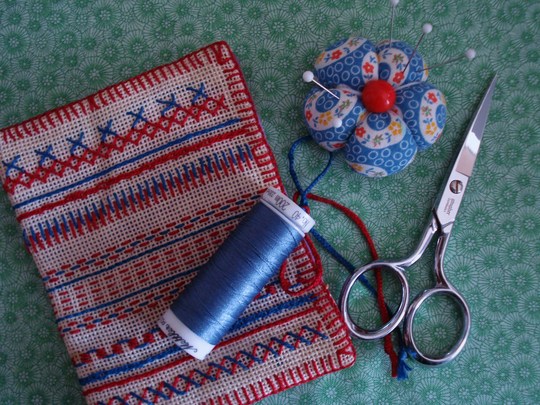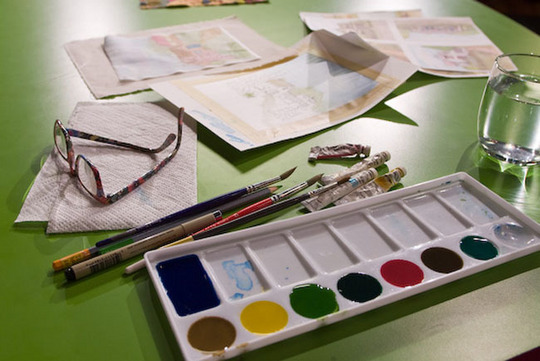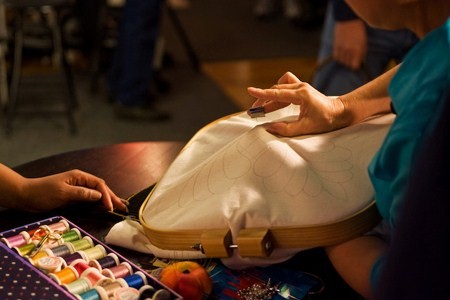
The Use of Needle Crafts in Occupational Therapy
By Stephanie Bergmann, OTR
Occupational Therapy began around the "Time of Enlightenment" (18th century) with the treatment of mentally ill patients. Having someone engage patients in purposeful activities that are of value, enables them to once again become a useful part of society. From the Revolutionary War to the present wars in Iraq and Afghanistan, occupational therapists have been there every step of the way rehabilitating wounded individuals to become independent in their everyday lives through motivational activities that are patient specific. These activities have ranged from wood working, machinists, to needlework.
Needle crafts have not only been used as a means to engage a patient into performing difficult tasks, but also to determine a patient's ability to function in everyday life. Claudie Allen, who has worked extensively with the mentally ill, developed a test using three sewing stitches on a square piece of leather; the running stitch, the whip stitch, and the cordovan stitch. This "sewing" test would help determine a patient's ability to adapt to changes, perform simple tasks independently, problem solve, as well as self correction. While not obvious to most, these tasks directly relate to a person's daily life. For example, if a patient is not able to maintain the flow of a running stitch and remember the sequence of the stitching steps, then he or she will probably not be successful in making a simple meal or dressing for inclement weather without assistance.
Occupational therapy's role in rehabilitation, in any setting and at any age, is to allow a person to be as independent as possible. This is done through evaluations by a skilled therapist, that focus on a patient's abilities and limitations given their diagnosis. In addition, leisure activities that are motivating to the patient need to be addressed. Therapy is not always painless in order to regain independence, but if therapy can coincide with what a person enjoys doing in their leisure such as sewing, tatting, or quilting, then they are much more likely to perform the required tasks. The key for the therapist is to find what motivates an individual and combine this with therapy for the patient's benefit.

Photo by Gregory Case
For example, I once had a right handed stroke patient who loved to needlepoint. But, due to his painful paralysis, he was no longer able to stitch. I constructed a table top with brackets that would hold his needlework loom as well as a dental floss box for cutting the yarn. While he was working on his needlepoint, I was able to help him perform range of motion exercises, as well as use his right arm to act as a support for his project. Over time, this gentleman was able to dress himself independently, cook a meal, drive, and continue his needlepoint with his right arm acting as an assistant. More importantly, he was able to go home to live by himself without the help of others, as well as continue his hobby; both of which were important to him.
It has been noted numerous times throughout my career as a therapist, that all I do is color, play and make things...I am known as the craft lady. Even when evaluating a new patient the typical response to the question of, "what goals do you have for therapy", the answer, more often than not, is "walking". This is a great goal, its gets a person from A to B. But when pressed for who is going to help them get dressed, go to the bathroom, perform personal hygiene, bath, cook, balance a check book, garden, plan a meal, or driving, etc...(the role of an occupational therapist is to ask!), then I usually have a patient's attention. To relearn and gain all the skills it takes to achieve independence can be accomplished in many ways; the use of needle crafts is just one means to an end.

Photo by Gregory Case
The use of needle arts to gain independence in the area of dressing, might not seem to have any correlation, so let me explain. The hand is able to perform over 200 different types of grip, pinch and in-hand manipulation techniques. In order to fasten a 1/2" button at least 5 pounds of force must be exerted onto the tips of the first three fingers, depth perception must be intact to align the correct hole with the button and coordination between the two hands to put the button into the hole. All this is required in order to be successful with one button. The simple one button task becomes more challenging when other problems exist such as macular degeneration, cataracts, arthritis, tremors due to medications or poor depth perception due to aging or lung disorders. A patient can gain independence with repetitive buttoning and unbuttoning of a blouse or shirt, but participation in this activity would be limited as well as mind numbingly boring.

Photo by Gregory Case
Quilting, sewing, knitting, and tatting all use the same mechanics as the buttoning tasks. Some things that come to mind are threading a needle, aligning stitches in a row, manipulating and holding thread in the palm of the hand, consistent tension on the thread itself for a more uniform stitch length and length in hand quilting. While not using these crafts for increasing strength and dexterity of a patient's hands and fingers, it is a cognitive task. Needle work evokes memories, for most of us, of our parents or grandparents doing such stitching on a nightly basis. Needle work can be calming for persons who are nervous and require a task that is repetitive and non-threatening, but that has a beginning and an end.
Visual scanning, depth perception, visual memories are all elements used for any needle craft. Remember looking for that perfect color, pattern or material to complete your last project? For persons who are depressed, a simple whip stitched wallet project to hold change for a vending machine soda can and enable that individual with a sense of accomplishment and motivation to seek out other acts of independence. Senior citizens who live alone and have no family, often lose their sense of purpose and usefulness to society. Knitting, sewing, or quilting baby layettes gives them a sense of value and purpose and assists those less fortunate with something beautiful for their newborns. Needle arts have also become a means to rise out of poverty and unemployment for many women in Africa, Asia and the United States. By purchasing these hand made items you give value to these women and their accomplishments.
In conclusion, you can call me the "Craft Lady," as well as an Occupational Therapist. I can smile because I know that by using crafts, they now have a common thread that winds its way into people's lives to enrich them, allow them to become independent and finally give them a sense of purpose.




.jpg)



I remember learning to use crafts with OT to increase eye/hand coordination. But over the years some OT's lost track of these benefits and instead used exercise modalities. Results are sometimes less helpful for increasing mobility and Activties of Daily Living functions.
We have been marginalised and sidelined by health services which are cost driven and want quick discharge, so not providing the opportunity to work with patients to achieve the optimum level of function. A wonderful article which clearly identifies the level of analysis OT undertake when using a particular activity.
RSS feed for comments to this post